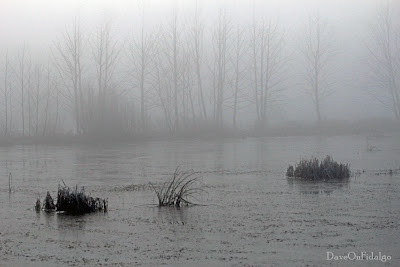Weather Wonderland
Photographing the weather can be a challenge. Weather is not an object that can be portrayed in an image. It is a condition of the atmosphere at a particular place and time. It is possible to make images of the weather's effects. For example, the wind cannot be photographed, but bending trees or crashing waves caused by the wind can be pictured.
For the past week, western Washington has been under the influence of both a lingering high pressure off the coast and a temperature inversion. The high has given us clear, calm sunny days. The inversion layer has trapped cold air near the ground under warmer air aloft. The calm conditions prevent the mixing of air layers. This is a recipe for chilly surface temperatures and morning fog in spots.
At home, the sun had come up under clear skies. With nice weather and a day off, I headed over to the dike at Wiley Slough in the Skagit River delta to try and catch some wildlife photos. The dike serves as a trail and makes it possible to hike out into the wetlands where the river approaches Puget Sound. On the drive, I encountered icy roads and found Fir Island under dense fog. Fog does not create the best conditions for wildlife photos. I wondered if it would last long and how productive the morning would be.
When I reached the dike, I found the weather conditions had created a mystical, icy world. It was probably about 26° F (-3° C) at the site and ice had formed on the surface of some of the marshes. Freezing fog had deposited a coating of rime frost on plants and shrubs. The unique beauty I encountered here abruptly switched the photo subject of the morning from wildlife to weather.
In the winter, these wetlands can be a dreary, brown-on-brown world. On this morning, however, the weather had created something magical. With fog playing tricks with the sunlight, ice-covered ponds and frosty coatings, these swamps and sloughs had been transformed into a mysterious wonderland. A calm stillness was interrupted only by an occasional tardy leaf falling from the mostly bare trees.
I did encounter some wildlife on the hike and I got a couple of fair shots. I spotted my Red-tailed Hawk friend from a previous visit. A pair of young Bald Eagles eyed me from the trees above the dike. I wondered if they were from the brood I spotted in the nest across the pond in the summer. A Northern Harrier soared and Trumpeter Swans flew in formation overhead demanding attention with their honking. In the distance, I heard Snow Geese on the move to a new field. A startled Great Blue Heron was heard but not seen. Juncos and sparrows foraged on the ground, Kingfishers chattered, ducks paddled and I was serenaded by a Raven singing baritone. Black-capped Chickadees, Robins and Towhees were still enjoying the fruits of the wild crab apples.
Though the wildlife was abundant, the star of the show on this day was the weather and what it had done to this amazing place. Hazy images, muted colors, frosty highlights and diffused sunlight created a unique experience and a great photo op. There will be other times to catch some wildlife photos.
The weather had created an early preview of the winter to come. As the morning progressed, the fog began to lift in spots. The frost and ice would soon disappear as the temperature rose into the low 40's. This magical weather world would be gone and again become a dismal brown-on-brown with just a bit of lingering green grass.
This is a mixed use area managed by the Washington Department of Fish and Wildlife. Walking out, I encountered some master birders (their spotting scopes give them away) who wanted to know if I had seen anything interesting. I felt briefly elevated to their level relating what I had spotted. From September to March, this is also a public duck hunting area. I saw no hunters on this visit, probably discouraged by the fog. It's just as well as there weren't many ducks around either. If you come for a visit, be sure to bring your Discover Pass.








